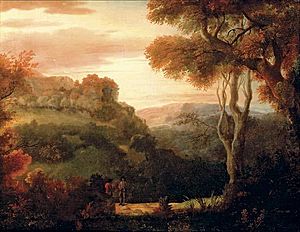Alexander Cozens facts for kids

Alexander Cozens (born 1717 – died 1786) was a British landscape painter. He was known for his beautiful watercolours. Cozens was born in Saint Petersburg, Russia. He taught drawing and wrote books about it. He even created a special way to draw landscapes from abstract ink blots. His son, John Robert Cozens, also became a famous artist.
Contents
About Alexander Cozens
Early Life and Education
Alexander Cozens was born in St. Petersburg, Russia. Many people used to think he was the son of Emperor Peter I of Russia. But he was actually the son of Richard Cozens, who worked for Peter I as a shipbuilder. Emperor Peter I was Alexander's godfather.
Alexander Cozens went to school in England starting in 1727. Later, he went back to Russia. In 1746, he sailed from St. Petersburg to Italy. He stayed there for two years. After Italy, he traveled to England. While in Rome, he worked in the art studio of a French landscape painter named Claude-Joseph Vernet.
Teaching and Exhibitions
From 1750 to 1754, Cozens was a drawing teacher at Christ's Hospital. During this time, he also started teaching private students. From 1763 to 1768, he taught drawing at Eton College. Some of his most important students included the Prince of Wales, Sir George Beaumont, and William Thomas Beckford. These three became very important art supporters and collectors in Britain.
In 1760, Cozens was one of the artists who showed their work at the first public art show in London. This exhibition was held at the Royal Society of Arts. Cozens also showed his art at the Royal Academy between 1772 and 1781.
Family Life
Alexander Cozens married Charlotte Pine. Her father was John Pine. They had a son, John Robert Cozens, who became an artist, and a daughter, Juliet Ann Cozens. Alexander Cozens passed away in London on April 23, 1786.
Cozens' Unique Art Style
Early Drawings
Before Cozens settled in Britain, he had a special style. You can see it in a collection of fifty-four early drawings at the British Museum. Most of these drawings show Italian scenes. Cozens lost them in Germany, but his son found them years later in Florence. These drawings show that Cozens was a very skilled artist. He was good at drawing detailed landscapes. Some drawings were just pen and ink. Others were done with pencil and ink. Some even had soft colours.
After he arrived in Britain, Cozens changed his style. He started to use broader strokes. He focused on creating big shapes and strong effects of light and shadow. You can see this in some of his drawings at the Victoria and Albert Museum.
The "Blot" Method
Cozens was famous for his unusual way of teaching drawing. One of his students, Henry Angelo, described it. Cozens would make accidental smudges and blots of black, brown, and grey ink on paper. Then, he would press these blots onto other paper. Using his imagination, he would turn these random shapes into amazing landscapes. He would see romantic rocks, woods, towers, rivers, and waterfalls in the blots. Blue and grey blots would become mountains, clouds, and skies.
In 1785, Cozens wrote a small book about this drawing method. It was called A New Method of Assisting the Invention in Drawing Original Compositions of Landscape. Cozens said a "blot" was "a production of chance with a small degree of design." He was inspired by Leonardo da Vinci's Treatise on Painting. Leonardo had suggested that artists could find ideas by looking at stains on old walls.
Other Works
In 1778, Cozens also published a book called Principles of Beauty relative to the Human Head. It had nineteen engravings by Francesco Bartolozzi. Many famous people, like Edmund Burke and Sir Joshua Reynolds, bought this book. Cozens also published books about different types of natural compositions. He also made a book about the shapes and leaves of thirty-two kinds of trees.
Public collections
See also

